Insect & Disease Conditions Update
Forest & Shade Tree - Insect & Disease Conditions for Maine
September 17, 2015
This is the last scheduled Conditions Report of the growing season. Updates may be passed along throughout the fall and winter via GovDelivery to electronic newsletter subcribers. These updates will be archived on our Conditions Reports Index Page along with past reports and the printable pdf version of this report: http://www.maine.gov/dacf/mfs/publications/condition_reports.html. Especially significant events will be reported to all subscribers.
Thank you for your continued interest in and contributions to these reports. We value your participation as you are a critical part of the forest health monitoring network. We wish you a safe and comfortable fall and winter.
Staff Transfer
Allison Kanoti has transferred to the Old Town office of the Maine Forest Service.
allison.m.kanoti@maine.gov or (207) 827-1813
PO Box 415, 87 Airport Road, Old Town, ME 04468
The Old Town office is normally staffed from 8am to 4pm Monday through Friday and the main number for the office is 827-1800. However, if you want to be sure to catch Allison in the office, please call ahead at 827-1813 or arrange an appointment through e-mail.
Insects
Asian Longhorned Beetle (Anoplophora glabripennis) – This year traps were deployed for Asian longhorned beetle (ALB) within and around the quarantine area around Worcester, MA. They caught their first adult ALB on the 14th of August within the current quarantine area. Looking for ALB this time of year has its advantages: the beetles are active until a hard frost; frass and sap are exuded from egg-laying sites and cracks in the bark and adult feeding activity may be visible. Adults feed on the main veins and stems of hardwood leaves and the tender bark of twigs; when significant, this can cause early leaf-drop. ALB has not been found in Maine, but early detection is critical. Monitor host trees (Maple, Birch, Elm, Willow Poplar, and others) for signs of damage from this pest. See: www.maine.gov/alb for more information. Source: UMASS Extension Landscape Message.
Browntail Moth (Euproctis chrysorrhoea) – The browntail larvae have hatched and are skeletonizing the leaves of host trees. The larvae are so small that they do not bite all the way through the leaf - they just scrape off the good green stuff leaving the rest of the leaf intact. This is especially noticeable on the tops of red oaks right now but can also be seen on apple trees. This is a heads up to look at your oaks and apples in southern Maine. People generally are not bothered by the browntail rash now but remember that this is still an issue raking leaves.
Damage can be seen in areas where there were lots of white moths flying in mid-July. This includes Bath, Bowdoin, Bowdoinham, Topsham (Sagadahoc County), Brunswick, Freeport and Falmouth (Cumberland County) and probably other areas not surveyed to date. In the past browntail has been restricted to coastal areas but we have seen small populations hang on in Lewiston (Androscoggin County), Augusta, Vassalboro, and Waterville (Kennebec County) in the past few years. The Maine Forest Service will be doing a more detailed winter web survey in January.
If you do see browntail damage on the tops of your trees it is not too early to start thinking about whether or not you want to control them next spring. Talk to your neighbors and to Licensed Pesticide Applicators (LPA) about treatments. Webs that are within reach can be clipped out during the winter and burned or dropped in soapy water. Pesticide treatments need to be done in May to be effective in providing relief from the rash so you need to line up an LPA before they get too busy. A list of LPA’s can be found at http://www.maine.gov/dacf/mfs/forest_health/invasive_threats/browntail_moth_pesticide_applicator_info.htm or you obtain a copy by contacting the Insect & Disease Laboratory.
Dogwood Sawfly (Macremphytus sp.) – In late July, samples of dogwood sawfly larvae were brought in from Augusta (Kennebec County) and Farmington (Franklin County) along with photos of severely defoliated dogwoods. Dogwood sawflies are native to this area. The damage they cause can be quite shocking—often whole hedges will appear to have been defoliated overnight. However, the next year’s buds are set by the time the leaves are stripped, and generally the hosts do not refoliate. Given that, overall impact on plant health appears to be minor, especially on multiple stem varieties of dogwood.
If you aren’t happy with decorative twigs in your yard from late-July through leaf-off, hand picking of larvae can be an effective management technique—just be sure to kill the larvae, or transfer them to a host in the woods, so they don’t find your prized ornamental. Chemicals registered for sawfly control such as Sevin and Spinosad are also effective. Scouting for larvae should begin in early July in southern Maine. Larvae will often be found on the undersides of the leaf surfaces. Treatment should occur before significant defoliation is noted.
One more note on this group—the larvae pupate in soft and rotting wood. This can cause concern when the wood is part of a deck, furniture or other structures where insect damage is unwelcomed.
If you aren’t happy with decorative twigs in your yard from late-July through leaf-off, hand picking of larvae can be an effective management technique—just be sure to kill the larvae, or transfer them to a host in the woods, so they don’t find your prized ornamental. Chemicals registered for sawfly control such as Sevin and Spinosad are also effective. Scouting for larvae should begin in early July in southern Maine. Larvae will often be found on the undersides of the leaf surfaces. Treatment should occur before significant defoliation is noted.
One more note on this group—the larvae pupate in soft and rotting wood. This can cause concern when the wood is part of a deck, furniture or other structures where insect damage is unwelcomed.
 Eastern Ash Bark Beetle (Hylesinus aculeatus) –Typically we get reports of eastern ash bark beetle when folks who heat with firewood notice the mountains of fine sawdust accumulating under their ash firewood. With the awareness of signs of emerald ash borer attack, including blonding (see below), we had several reports of this native beetle on standing ash (Winthrop (Kennebec County), Dresden (Lincoln County) and Parkman (Piscataquis County)). Eastern ash bark beetle is not successful in attacking vigorous trees, so is not a serious forest pest. Please continue to report all blonding of ash so we can rule out emerald ash borer infestation.
Photo 1: Blonding caused by woodpecker attack on eastern ash bark beetle. Photo: Sue Myers, Maine Forest Service, Forest Protection Division
|
Emerald Ash Borer (Agrilus planipennis) – Emerald ash borer has not been found in Maine. Purple traps are beginning to be retrieved across the state. This fall and winter be on the lookout for “blonding” of ash trees caused by woodpeckers. These trees are worth a second look, as they may be host to emerald ash borer. For more information about blonding, follow the link for “Blonding on ash” from this website: http://nhbugs.org/emerald-ash-borer.
Fall Webworm (Hyphantria cunea) – Fall webworm populations are at noticeable levels in most areas of the state, and quite notable levels in Downeast Maine. These caterpillars often cause alarm because they festoon trees in open spaces and along edges with their tents, sometimes enveloping whole trees. Even though trees may be completely stripped of foliage by fall webworm, the damage caused is minimal due to the timing of defoliation. These caterpillars can be thought of as a free buffet for some of our generalist predators and parasites—they provide ample food to beneficial insects, while causing little harm to their hosts. If they are not a buffet you want in your ornamental trees, scout for and remove small webs beginning in early July next year. This year, you can try to remove existing webs by twisting them around a forked stick. Lighting them on fire while they are still in the tree is not recommended—at a minimum you risk significant damage to the tree.
Forest Tent Caterpillar (Malacosoma disstria) – As reported, this caterpillar was noticed by many earlier this summer. Some light trap catches are tallied, and so far the traps in Turner (Androscoggin County), Ashland and Crystal (Aroostook County) and Hope (Knox County) are showing high catches of the adult moths. This is an insect to watch for next year.
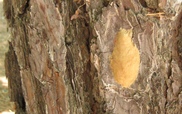 Gypsy Moth (Lymantria dispar) – A gypsy moth outbreak snuck up on residents of southern New England this year. Forest health staff in Massachusetts attributed the caterpillar’s success to a dry summer in 2014 and a dry spring in 2015 sparing the insect from the fungal disease, Entomophaga maimaiga. MFS will be conducting an egg mass survey later this year to try to forecast next year’s damage. Dry conditions in areas traditionally hard-hit by gypsy moth may have supported building populations. Homeowners can also do their own surveys with the aim of reducing next year’s defoliation. Look for gypsy moth egg masses around your yard and destroy those you can reach.
Photo 2: Fresh gypsy moth egg mass on a mature red pine. Photo: Maine Forest Service
|
-
Where to look? Almost anywhere. Gypsy moth females often deposit their eggs very close to where they pupated. Therefore eggs are often in protected locations such as bark cracks, in building eaves, under stacked lumber or other material, on the undersides of: branches, rocks, picnic tables, lawnmowers…wherever the caterpillar, and later the adult female, found a safe place.
-
What to look for? Egg masses will be buff-colored, irregularly shaped masses. They usually are between 1/2” and 2” long, and ~1/2” to 1” wide. The eggs, which resemble tiny marbles, are covered with a protective layer of the hair from the female moth’s abdomen.
- How to destroy? Make sure to remove the eggs from the landscape. You can seal them tightly in a plastic bag and dispose of them in the trash; soak them overnight in a solution of warm soapy water; or treat them with in place with horticultural oil labeled for gypsy moth control.
Source: Michigan Extension News
Photo 3: Dry conditions in areas traditionally hard-hit by gypsy moth and affected by hemlock woolly adelgid may spell trouble for their hosts. Image Source: Northeast Regional Climate Center
|
|
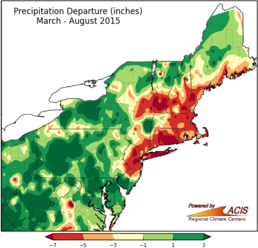 |
 Hemlock Woolly Adelgid (Adelges tsugae) – Dry conditions this growing season in the coastal region of the state will exacerbate damage from hemlock woolly adelgid. Accelerated hemlock decline and mortality as a result of a combination of hemlock woolly adelgid damage and drought stress may begin to accumulate. As might be expected, this is anticipated to be the worst on sites that are most prone to drought stress.
A new publication titled Managing Hemlock in Northern New England Forests Threatened by Hemlock Woolly Adelgid and Elongate Hemlock Scale is now available on-line. This publication was made possible through competitive grants from the USDA Forest Service and collaborative efforts between the USFS State and Private Forestry staff in Durham and Maine, New Hampshire and Vermont forest health staff. There will be a limited printing also supported by the grants. Please contact Patti Roberts at patti.roberts@maine.gov or (207) 287-2431 if you would like to receive a hardcopy when they become available. A link to the pdf can be found at: www.maine.gov/forestpests#hwa.
Photo 4: Cover of new hemlock publication. Source: USDA FS
|
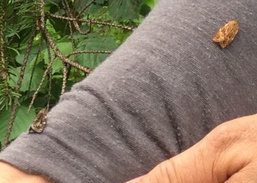 Spruce Budworm (Choristoneura fumiferana) – Spruce budworm traps are being collected now by MFS staff, large landowners and land managers across the northern half of the state. The first trap catches counted to date are slightly higher than last year but it is a very small subset of traps put out. There was a large moth flight out of Quebec in mid-July that could be tracked on radar. Most of it appeared to land in the Gaspe Peninsula and New Brunswick and did not make it to Maine.
Photo 5: Spruce budworm moths, Forestville, Quebec. Photo: Maine Forest Service
|
Diseases and Injuries
 Ash Health – Some Common Diseases, Declines – The continuing concern surrounding the likely imminent discovery of the emerald ash borer (EAB) in Maine has led landowners, foresters, and the general public to report the locations of many ashes and ash stands in an unhealthy condition. This heightened awareness is critical to our mission of detecting EAB as soon after its introduction to the state as possible. We appreciate the vigilance and concern shown and encourage continued support and attention to the problem.
Ashes and ash stands in Maine do have several significant health problems, and one or more of these has often been found as the cause of individual tree or stand decline reported to date. The following is a brief review of ash problems that are likely to be encountered, many of which have symptoms similar to those initiated by EAB.
Photo 6: Dead and declining ash in a fence-row, a typical location for ash yellows, Corinth, Maine. Photo: Maine Forest Service
|
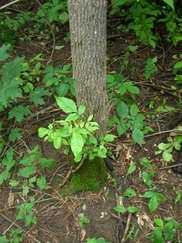 Ash Yellows: The ash yellows pathogen is a phytoplasma organism (similar to bacteria) which invades and colonizes the phloem system of its ash host and develops into a systemic infection. The phytoplasma are presumed to be transmitted by leafhoppers or related insects. Infection by the ash yellows organism results in a gradual growth decline of the tree, with symptomatic dieback of tops and branches occurring over several years. Other symptoms can include epicormic sprouting along the bole and branches, and bark splitting or cracking. Open fields and pastures provide the habitat used by the insect vectors. Because the pathogen is dependent on insect transmission to new hosts, ashes in fence-rows or near open fields are more likely to be infected than those in forest stands. For more information on ash yellows, refer to: http://www.na.fs.fed.us/pubs/howtos/ht_ash/ash_yell.pdf
Photo 7: Epicormic sprouting of ash, a symptom typical of ash yellows, Dover-Foxcroft, Maine. Photo: Maine Forest Service
|
 Ash Trees and Ice Storms: Although it has been seventeen years since the famous ice storm of 1998, damage to ashes from this and from more recent storms continues to affect many stands. While crown damage to affected trees has largely been masked now by healthy recovery, more significant damage has become evident in many cases. Examination of several sites in high-impact areas of the ice storm has revealed that ash trees which had moderate to severe top damage are now declining and dying from infection by Armillaria root rot. Evidence indicates that the trees were rapidly infected with Armillaria many years ago, usually within a year or two following the ice storm. Following damage from ice storms, ash crowns are known to sprout and rebuild at a remarkable rate. Many ash crowns appeared to be in full health just a few years following the storm.
The damage and the regrowth were not without long-term consequences, however. Rebuilding the crowns surely depleted the energy (starch) reserves in the roots, and this led to rapid colonization by Armillaria. Now root and butt decay is extensive enough to result in tree decline and mortality. Additional information on the long-term effects of ice storms on tree survival and decline, see: http://www.fs.fed.us/nrs/pubs/rp/rp_nrs25.pdf
Photo 8: Mycelial "fan" and decay associated with Armillaria root rot on ice-storm damaged ash, Bridgton, Maine. Photo: Maine Forest Service
|
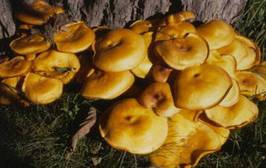 Post-harvesting Decline: Residual stand damage resulting from injuries made during harvesting activities continues to be a problem in some woodlots. Direct mechanical injury to the roots and root crowns serve as infection courts for invasion by root and butt decay organisms. As with damage inflicted by ice storms, it may take many years or even decades before the root decay develops to the point of causing visible dieback and decline in the crowns. Again, infection by the root rot pathogen, Armillaria spp., is common on declining trees.
Photo 9: Mushrooms of Armillaria mellea root rot on ash, Durham, New Hampshire. Photo: W. Ostrofsky
|
Ash Leaf and Twig Rust: Many ashes, especially those in coastal counties, have been damaged from a leaf disease known as ash leaf rust (causal agent: Puccinia sparrganioides). Serious epidemics occur rather infrequently, but at least some damage is seen every year. Heavy damage in a single year or consecutive years of defoliation from this disease may lead to ash with decline symptoms including branch and top dieback, epicormic sprouting and stunted leaf and shoot growth. Additional information of ash leaf rust can be found in the July 21, 2015 issue of our Forest & Shade Tree - Insect & Disease Conditions for Maine.
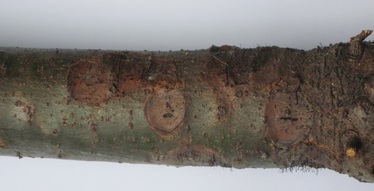 Caliciopsis Canker of White Pine - Survey Update – Caliciopsis canker (Caliciopsis pinea) is a disease that has been historically associated with overstocked, pole-sized white pine stands of low vigor. More recently, it has been observed to be more aggressive in some situations, so a re-examination study of the disease was initiated, with the USDA Forest Service, New Hampshire DRED, Maine Forest Service, and the Univ. of Maine as cooperators. The survey and research effort is on-going in both Maine and New Hampshire. A summary of only the Maine Forest Service efforts are outlined here.
In 2014, twenty randomly selected stands were surveyed in Maine, with Caliciopsis pinea identified on white pine regeneration from 16 stands surveyed. Caliciopsis symptoms in overstory trees were also identified in 16 stands, but not always from those with infected white pine regeneration. Relationships between tree stress resulting from the white pine needle disease complex, and the incidence and severity of Caliciopsis canker have not been established, but may become apparent as studies continue.
In 2015, the study was expanded to assess Caliciopsis canker incidence and severity as it may be related to soil type characteristics. An additional sixteen white pine stands were surveyed for the canker disease in Maine and the data will be combined with similar data collected in New Hampshire by USDA Forest Service and New Hampshire DRED personnel. Of the sixteen plots surveyed in Maine this year, fruiting of the pathogen was found on sapling–sized white pines in ten of the stands. Symptoms of pitching (pitch streaks along the main bole) were observed in all sixteen stands. Percentage of white pines exhibiting pitching ranged from a low of 10% in a stand in Lyman, to73% in a stand in Shapleigh. Although pitching is one criterion for assessing infection by Caliciopsis, not all pitching is likely the result of infection by this pathogen. Detailed canker analyses are being conducted by University of Maine, other State, and USDA Forest Service cooperators to determine the reliability of using pitching as a survey tool for this disease.
Photo 10: Cankers of Caliciopsis pinea on a white pine sapling, Seboomook Twp, Maine. Note the fruiting bodies (hair-like projections) along stem edge. Photo: Maine Forest Service
|
Conditions Report No. 4, 2015
On-line: http://maine.gov/dacf/mfs/publications/condition_reports.html
Department of Agriculture Conservation & Forestry
Maine Forest Service - Forest Health and Monitoring
Contributors: Charlene Donahue, Allison Kanoti, William Ostrofsky
|